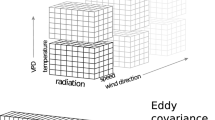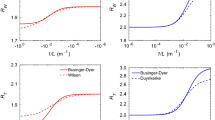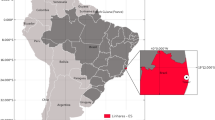Abstract
To convert measurements of windspeed, eddy flux and scalar concentration into estimates of surface scalar exchange, we implicitly or explicitly assimilate the measurements into mathematical statements of the mass balance in a control volume on a representative patch of the surface. The form of this statement depends on the coordinate system in which it is written and the coordinate system should be chosen so that measurements can be used optimally. This requirement imposes a set of conditions on the coordinates. Here we perform a comparative analysis of some candidate coordinate systems, concentrating on the Cartesian and physical streamline systems. We show that over gentle topography there are definite advantages in working in streamline coordinates. Transforming measurements of vector and tensor quantities measured in the reference frame, s i, of the anemometer into the reference frame, e i, of the chosen coordinate system involves using the measured statistics of the wind field to define three Euler rotation angles. We compare the method in most common use, which employs the components of the mean wind vector and the Reynolds stress tensor to define these angles, with the more recent ‘planar-fit’ method that uses instead an ensemble of mean wind vectors to define the rotations. We find that, in real flows, the standard method has a previously unrecognized closure problem that ensures that the third rotation angle defined using the stress tensor or scalar flux vector will always be in error and often give unphysical results. An alternative procedure is recommended. Finally, the relationships between measurements and model outputs are discussed.
Similar content being viewed by others
References
Aris R.: 1962, Vectors, Tensors and the Basic Equations of Fluid Mechanics, Prentice-Hall Inc., U.S.A., 286 pp.
Baldocchi D., Finnigan, J., Wilson, K., and Paw U, K. T.: 2000, 'On Measuring Net Ecosystem Carbon Exchange over Tall Vegetation in Complex Terrain', Boundary-Layer Meteorol. 96, 257–291.
Baldocchi, D. D., Falge, E., Gu, L., Olson, R., Hollinger, D., Running, S., Anthoni, P., Bernhofer, Ch., Davis, K., Evans, R., Fuentes, J., Goldstein, A., Katul, G., Law, B., Lee, X., Malhi, Y., Meyers, T., Munger, W., Oechal, W., Paw U, K. T., Pilegaard, K., Schmid, H. P., Valentini, R., Verma, S., Vesala, T., Wilson, K., and Wofsy, S.: 2001, 'FLUXNET: A New Tool to Study The Temporal and Spatial Variability of Ecosystem-Scale Carbon Dioxide, Water Vapour and Energy Flux Densities', Bull. Am. Meteorol. Soc. 82, 2415–2434.
Baldocchi, D. D., Valentini, R., Running, S. R., Oechel W., and Dahlman, R.: 1996, 'Strategies for Measuring and Modelling CO2 and Water Vapor Fluxes over Terrestrial Ecosystems', Global Change Biol. 2, 159–168.
Bradshaw, P.: 1973, Effects of Streamline Curvature on Turbulent Flow, AGARDograph No. 169. National Technical Information Service, US Dept. of Commerce, 125 pp.
Ferziger, J. H. and Peric, M.: 1997, Computational Methods for Fluid Dynamics, Springer-Verlag, Berlin, Heidelberg, 364 pp.
Finnigan, J. J.: 1983, 'A Streamline Coordinate System for Distorted Two-Dimensional Shear Flows', J. Fluid Mech. 130, 241–258
Finnigan, J. J.: 1990, 'Streamline Coordinates, Moving Frames, Chaos and Integrability in Fluid Flow'. in H. K. Moffat and A. Tsinober (eds)., Topological Fluid Mechanics, Proc. IUTAM Symp. Topological Fluid Mechanics, Cambridge 1989, Cambridge University Press, Cambridge, pp. 64–74.
Finnigan, J. J.: 1999, 'A Comment on the Paper by Lee (1998) On micrometeorological Observations of Surface-Air Exchange over Tall Vegetation', Agric. For. Meteorol. 97, 55–64.
Finnigan, J. J. and Belcher, S. E.: 2004, 'Flow over a Hill Covered with a Plant Canopy', Quart. J. Roy. Meteorol. Soc. 130, 1–29.
Finnigan, J. J. and Bradley, E. F.:1983, 'The Turbulent Kinetic Energy Budget behind a Porous Barrier: An Analysis in Streamline Coordinates', J. Wind Eng. Ind. Aerodyn. 15, 157–168.
Finnigan, J. J., Clements, R., Malhi, Y., Leuning, R., and Cleugh, H.: 2003, 'A Re-Evaluation of Long-Term Flux Measurement Techniques. Part I: Averaging and Coordinate Rotation', Boundary-Layer Meteorol. 107, 1–48.
Geissbuhler, P., Siegwolf, R., and Eugster, W.: 2000, 'Eddy Covariance Measurements on Mountain Slopes: the Advantage of Surface-Normal Sensor Orientation over a Vertical Set-Up', Boundary-Layer Meteorol. 96: 371–392.
Goulden, M. L., Munger, J. W., Fan, S-M., Daube, B. C., and Wofsy, S. C.: 1996, 'Measurements of Carbon Sequestration by Long-Term Eddy Covariance Methods and a Critical Evaluation of Accuracy', Global Change Biol. 2, 169–183.
Howarth, L.: 1951, 'The Boundary-Layer in Three Dimensional Flow-Part 1. Derivation of the Equations for Flow along a General Curved Surface', Phil. Mag. 42, 239–243.
Hunt, J. C. R., Leibovich, S., and Richards, K.J.: 1988b, 'Turbulent Shear Flow over Low Hills', Quart. J. Roy. Meteorol. Soc. 114, 1435–1470.
Hunt, J. C. R., Weng, W. S., and Carruthers, D. J.: 1988a, 'Modelling Deposition Fluxes on Hills', in H. van Dop (ed.), Air Pollution Modelling and its Applications, Plenum Press, New York, 702 pp.
Kaimal, J. C. and Finnigan, J. J.: 1994, 'Atmospheric Boundary Layer Flows: Their Structure and Measurement', Oxford University Press, New York, 249 pp.
Kaimal, J. C. and Gaynor, J. E.: 1983, 'The Boulder Atmospheric Observatory', J. Clim. Appl. Meteorol. 22: 863–880.
Kobayashi, M. H., Pereira, J. C. F., and Siqueira, M. B. B.: 1994, 'Numerical Study of the Turbulent Flow over and within a Model Forest on a 2D Hill', J. Wind Eng. Ind. Aerodyn. 53, 357–374.
Kuo, Y. H. and Schlatter, T. W.: 1990, Mesoscale Data Assimilation. Notes from an NCAR Summer Colloquium, NCAR, Boulder, CO, 644 pp.
Lee, X.: 1998, 'On Micrometeorological Observations of Surface-Air Exchange over Tall Vegetation', Agric. For. Meteorol. 91, 39–49.
Lee, X, Finnigan, J. J., and Paw U, K. T.: 2004, 'Coordinate Systems and Flux Bias Error', in X. Lee, S. Verma, B. Law (eds.), Handbook of Micrometeorology: A Guide for Surface Flux Measurements, Chapter 3. Kluwer Academic Publishers, Dordrecht, in press.
McMillen, R. T.: 1988, 'An Eddy Correlation Technique with Extended Applicability to Non-Simple Terrain', Boundary-Layer Meteorol. 43, 231–245.
Milne-Thompson, L. M.: 1965, Theoretical Hydrodynamics, MacMillen & Co. Ltd., London, 743 pp.
Misner, C. W., Thorne, K. S., and Wheeler, J. A.: 1973, Gravitation, W.H. Freeman and Co. San Francisco, CA, 1279 pp.
Padro, J.: 1987, 'Boundary-Layer Pollutant Concentrations over Complex Terrain', Boundary-Layer Meteorol. 38, 17–28.
Padro, J. and Walmsley, J. L.: 1990, 'A Mixed Spectral Finite-Difference Model for Pollutant Concentrations over a Hill', Boundary-Layer Meteorol. 51, 343–363.
Paw U, K. T., Baldocchi, D., Meyers, T. P., and Wilson, K. B.: 2000, 'Correction of Eddy-Covariance Measurements Incorporating both Advective Effects and Density Fluxes', Boundary-Layer Meteorol. 97, 487–511.
Philip, J. R.: 1996, 'One-Dimensional Checkerboards and Blending Heights', Boundary-Layer-Meteorol. 77, 135–151.
Pielke, R. A.: 1984, Mesoscale Meteorological Modeling, Academic Press, New York, 612 pp.
Raupach, M. R.: 1989, 'Stand Overstory Processes', Phil. Trans. Roy. Soc. Lond. B 324, 175–190.
Raupach, M. R.: 2001, 'Inferring Biogeochemical Sources and Sinks from Atmospheric concentrations: General Considerations and Applications in Vegetation Canopies', in E.-D. Shulze, M. Heimann, S. Harrison, E. Holland, J. Lloyd, I. C. Prentice, and Schimel, D. (eds.), Global Biogeochemical Cycles in the Climate System, Academic Press, pp. 41–59.
Raupach, M. R., Weng, W. S., Carruthers, D. J., and Hunt, J. C. R. 1992, 'Temperature and Humidity Fields and Fluxes over Low Hills', Quart. J. Roy. Meteorol. Soc. 118, 191–225.
Sakai, R. K., Fitzjarrald, D. R., and Moore, K. E.: 2001, 'Importance of Low-Frequency Contributions to Eddy Fluxes Observed over Rough Surfaces', J. Appl. Meteorol. 40, 2178.
Schmid, H. P.: 2002, 'Footprint Modeling for Vegetation-Atmosphere Exchange', Agric. For. Meteorol. 113, 159–183.
Spiegel, M. R.: 1959, Vector Analysis. Schaum's Outline Series, McGraw-Hill Book Co., New York, NY, 225 pp.
Tanner, C. B. and Thurtell, G. W.: 1969, Anemoclinometer Measurements of Reynolds Stress and Heat Transport in the Atmospheric Surface Layer, Dept. of Soil Science, Univ. of Wisconsin, Madison, WI, Research and Development Technical Report ECOM 66-G22-F to the US Army Electronics Command.
Van Ulden, A. P. and Wieringa, J.: 1996, 'Atmospheric Boundary-Layer Research at Cabauw', Boundary-Layer Meteorol. 78, 39–69.
Wilczak, J. M., Oncley, S. P., and Sage, S. A.: 2001, 'Sonic Anemometer Tilt Correction Algorithms', Boundary-Layer Meteorol. 99, 127–150.
Wilson, J. D., Finnigan, J. J., and Raupach, M. R.: 1998, 'A First-Order Closure for Disturbed Plant-Canopy Flows, and its Application to Winds in a Canopy on a Ridge', Quart. J. Roy. Meteorol. Soc. 124, 705–732.
Wood, N., Hewer, F., and Hobson, M.: 1997, BLASIUS Version 3.02: Documentation of a Model of Flow over Hills. UKMO Atmospheric Processes Research Technical Note, 93 pp.
Xu, D. and Taylor, P. A.: 1992, 'A Non-Linear Extension of the Mixed Spectral Finite Difference Model for Neutrally Stratified Flow over Topography', Boundary-Layer Meteorol. 59, 177–186.
Yih, C.-S.:1977, Fluid Mechanics: A Concise Introduction to the Theory, Ann Arbor West River Press, 633 pp.
Zeman, O. and Jensen, N. O.: 1987, 'Modification of Turbulence Characteristics in Flow over Hills', Quart. J. Roy. Meteorol. Soc. 113, 55–80.
Author information
Authors and Affiliations
Rights and permissions
About this article
Cite this article
Finnigan, J.J. A Re-Evaluation of Long-Term Flux Measurement Techniques Part II: Coordinate Systems. Boundary-Layer Meteorology 113, 1–41 (2004). https://doi.org/10.1023/B:BOUN.0000037348.64252.45
Issue Date:
DOI: https://doi.org/10.1023/B:BOUN.0000037348.64252.45




